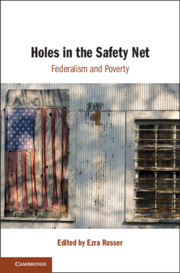Book contents
- Holes in the Safety Net
- Holes in the Safety Net
- Copyright page
- Dedication
- Contents
- Contributors
- Acknowledgments
- Introduction
- Part I Welfare and Federalism
- Part II States, Federalism, and Antipoverty Efforts
- 4 States’ Rights and State Wrongs
- 5 State and Local Tax Takeaways
- 6 Early Childhood Development and the Replication of Poverty
- 7 States Diverting Funds from the Poor
- 8 States’ Evolving Role in the Supplemental Nutritional Assistance Program
- Part III Advocacy
- Index
6 - Early Childhood Development and the Replication of Poverty
from Part II - States, Federalism, and Antipoverty Efforts
Published online by Cambridge University Press: 05 September 2019
- Holes in the Safety Net
- Holes in the Safety Net
- Copyright page
- Dedication
- Contents
- Contributors
- Acknowledgments
- Introduction
- Part I Welfare and Federalism
- Part II States, Federalism, and Antipoverty Efforts
- 4 States’ Rights and State Wrongs
- 5 State and Local Tax Takeaways
- 6 Early Childhood Development and the Replication of Poverty
- 7 States Diverting Funds from the Poor
- 8 States’ Evolving Role in the Supplemental Nutritional Assistance Program
- Part III Advocacy
- Index
Summary
Antipoverty efforts must begin early because abundant evidence demonstrates that experiences during the first five years of life lay a foundation for future learning and the acquisition of skills. Public investments can help foster early childhood development, but these efforts must begin early and must involve both parents and children. This chapter describes the patterns of convergence and divergence in state approaches to supporting early childhood development. For the prenatal period until age three, the federal government is the primary source of funds, and there is fairly limited variation in how this money is spent across the states. For the period from age three until entrance to kindergarten, the federal government and states largely share the cost of supporting early childhood development, leading to significant differences among the states, particularly in access to preschool for three- and four-year-olds. This chapter explores these funding differences, emphasizing the political economy of state choices and noting that, perhaps surprisingly, some conservative-leaning states, not known for generous social welfare spending, are making a substantial effort to invest in early childhood education, especially for four-year-olds. The chapter closes with insights for both advocates and scholars.
- Type
- Chapter
- Information
- Holes in the Safety NetFederalism and Poverty, pp. 130 - 150Publisher: Cambridge University PressPrint publication year: 2019
- 2
- Cited by

